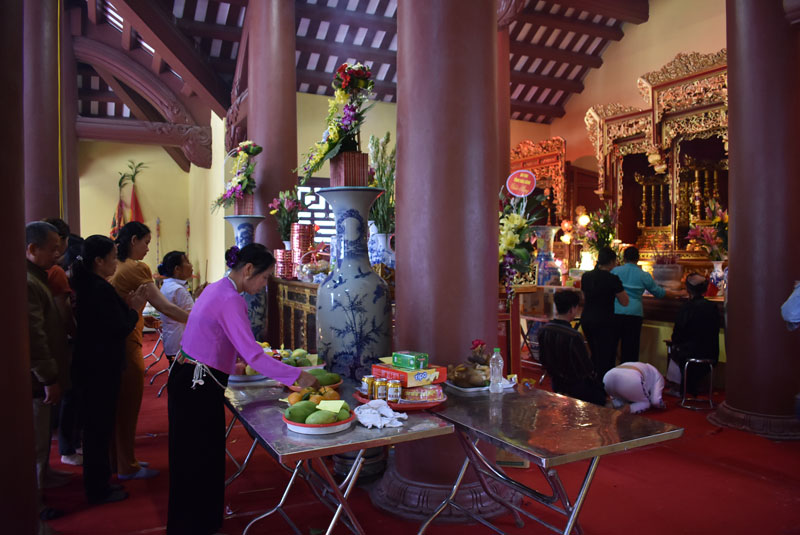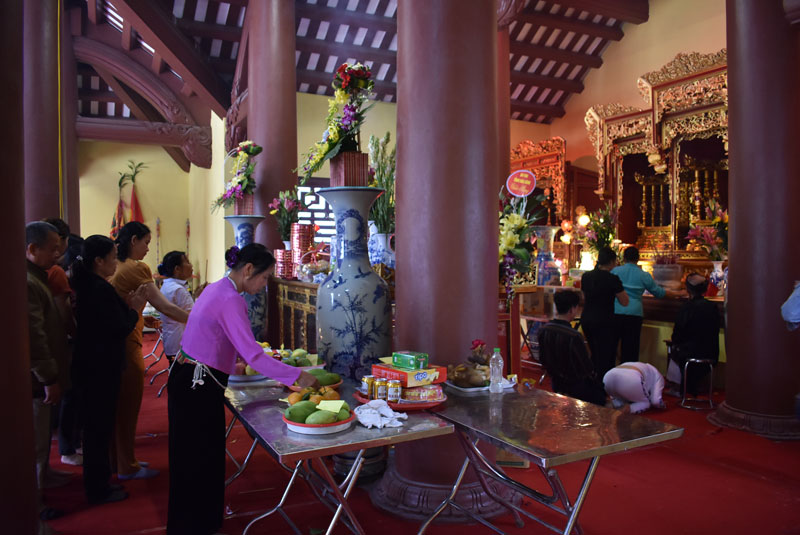
(HBO) - Historically, Quen Thi village in Cao Duong commune, Luong Son district was born a few hundred years ago. At first, there were only seven households from other places to settle here. Later, it developed into a village called Trai Mit village, which is now called Quen Thi village. About 300 years ago, the people of Quen Thi village built a communal house to worship the Gods Tan Vien Son, Cun Truong Thung, and the Citadel of the village.
Quen Thi Communal House in Cao Duong commune (Luong Son) was built nicely, meeting the spiritual needs of the local people.
It is not only is a religious place, the village communal house is also a meeting place to discuss the village’s matters. The communal house was built in the middle of the field, looking the south. In the east, west and north there are limestone mountains that cover the village campus. Quen Thi communal house has been expanded into seven compartments, with a harem and it was built with precious wooden. The communal house was degraded over the time. In 1996, the people of Quen Thi village contributed their labor and money to rebuilding the communal house at the right old place to worship the gods, Tan Vien Son and the Citadel of the village.
During the year, Quen Thi communal house often holds five main festivals, in which the spring festival on the 12th of January is held the most solemnly. The festival includes the ceremony to hold the palanquin procession of Duc Mau's incense bowl to the eldest communal house. After the ceremony stopped at the right place, the folk games, antiphonal singing, cultural and sports activities take place. These activities always attract the people of the whole village to participate. On April 4 of the lunar calendar, the communal house held a ceremony to pray for water plating. The village’s shaman prays for good rain, good weather and good crops. On 12 June of the lunar calendar is a ceremony to go to the field. The village’s shaman prays the gods, the heaven and earth for the permission to go to the field. After the ceremony, the villagers are allowed to go transplanting in the fields. The 18th August of lunar month is a ceremony to wash rice leaves. At this time, rice is standing and easily being damaged by pests and other diseases. The people in the village pray for good weather and no pests and diseases can destroy the crops. On the 12th of October, the new rice ceremony is celebrated. At this time, rice begins to be collected home. This is a ceremony to thank the gods, the heaven and earth to have helped them with the good harvest, the prosperous and healthy business and good health.
The People’s Committee of Lac Son district held a ceremony on April 28 to receive the provincial relic certificate for the ancient rock carving site at Suoi Co stream, located in My Thanh commune.
A special music show titled "The country is in the fullness of joy” has been held at Hoa Binh Square in Hoa Binh city in celebration of the 50th anniversary of the liberation of the South and national reunification (April 30, 1975–2025).
The People's Committee of Lo Son commune, Tan Lac district, has organised the local annual traditional stream fishing festival on April 19 - 20.
As a land deeply intertwined with human history and Vietnam’s millennia-long journey of nation-building and defence, Hoa Binh is often revered for its epic tales and legends.
Residents of Hoa Binh boast a rich cultural identity, reflected in their unique language, traditional attire, customs, and folk melodies – described as "sweet as honey, clear as a mountain stream.”
Lac Son district’s Vu ban town held the 2025 Truong Kha temple festival on April 12–13 (the 15th–16th days of the third lunar month). Since its revival in 2019, the festival has been organised every three years, preserving valuable intangible heritage while meeting the community’s cultural and spiritual needs.



